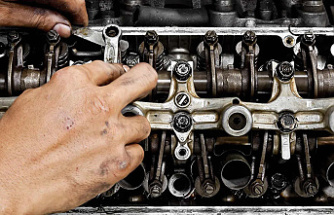A tell-tale sign of a kidney stone is pain in a person's side, back and below the ribs. About one in every ten individuals will experience the pain of having a kidney stone in their lifetime, said Dr. Mark Redwood, the division head of the Department of Urology at Sinai Hospital. The pain from passing a stone can be so intense that some people compare it to giving birth. But Redwood says there are many treatments for kidney stones.
What is a kidney stone?
When many of the materials and byproducts from the normal function of the kidneys collect into a solid form, they are called stones. Stones can take on many shapes and sizes, it often depends on how long it takes for them to form - months verses years. Eighty-five percent of stones are calcium in composition. The rest are uric acid, which are a result of the breakdown of protein in the body and rare metabolic diseases. Uric acid stones are similar composition to the crystals that form in the tissues during a gout attack.
What are the risk factors for kidney stones?
The most common risk factor for the formation of kidney stones is dehydration. Water is one of the best sources of fluids, but people should stay away from sugar sweetened drinks and fruit punches.
Although the rate varies quite a bit, studies suggest the average person loses about 1% of muscle every year after about age 50, says Dr. Elena Volpi , director of the Sealy Center on Aging at the University of Texas Medical Branch in Galveston. (Feb. 23, 2017)
Although the rate varies quite a bit, studies suggest the average person loses about 1% of muscle every year after about age 50, says Dr. Elena Volpi , director of the Sealy Center on Aging at the University of Texas Medical Branch in Galveston. (Feb. 23, 2017)
Johns Hopkins Bloomberg School of Public Health recommend opening two facilities where people can safely do drugs. They suggest opening one on the east side and one on the west side of the city. (Kevin Richardson/Baltimore Sun video)
Johns Hopkins Bloomberg School of Public Health recommend opening two facilities where people can safely do drugs. They suggest opening one on the east side and one on the west side of the city. (Kevin Richardson/Baltimore Sun video)
Another risk factor can be cold weather. Because we don't usually feel ourselves sweating and are not as thirsty as we are when it's hot, we only tend to drink at mealtimes during the winter. Most stones are actually formed in the winter when our fluid intake is reduced, but often pass out of the body in the summer.
Certain metabolic conditions can also contribute to kidney stones, such as disease of the parathyroid gland, which regulates calcium balance in the body. Inflammatory bowel disease, such as Crohn's disease, can also raise the risk of kidney stones. In Crohn's disease, the small bowel does not manage calcium from an individual's diet efficiently. This can happen during prolonged hospitalizations because being sedentary can lead to reabsorption of bone and calcium similar to what occurs in astronauts after being in space and weightlessness for long periods of time.
Tom Brady, the 39-year-old New England Patriots quarterback who just won his fifth Super Bowl, says he isn't retiring. That may be disappointing to his wife, the Atlanta Falcons and Ravens fans. But it may be reassuring to many 40-plus amateur athletes. Dr. Louis Kovacs, a physician at the Arnold...
Tom Brady, the 39-year-old New England Patriots quarterback who just won his fifth Super Bowl, says he isn't retiring. That may be disappointing to his wife, the Atlanta Falcons and Ravens fans. But it may be reassuring to many 40-plus amateur athletes. Dr. Louis Kovacs, a physician at the Arnold...
Another risk Cepbahis factor is human behavior. Some people just don't like to drink water so they don't drink it.
It is a common urban legend that kidney stones form from eating too many antacids and sodas. For the most part, most calcium that is eaten is removed from the body in the stool.
How are kidney stones treated?
The treatment of kidney stones is dependent on the size and location of the stones at time of presentation. Smaller kidney stones pass through the body on their own.
Urologists, or specialists who treat kidney stones, usually divide the urinary system into the upper third of the ureter en iyi bahis siteleri and kidney, and lower ureter and bladder. Stones in the kidney less than 1.5 cm can effectively be treated with shock wave lithotripsy. This is a technology that uses ultrasound energy directed at the stones to fragment them into sand so the patient can pass the pieces naturally in the urine.
Because the density of the stones can vary from patient to patient, a stone may need more than one treatment. If the stone is causing blockage of the ureter or kidney, the urologist may insert a stent, a flexible tube that extends from the kidney down the ureter to the bladder to allow the urine to bypass the stone down to the bladder.
Larger stones in the kidney can be treated with serial shock wave lithotripsy or percutaneous neprholithotomy. This is a technology that allows access to larger stones using a small tube placed through the back into the kidney. The stone is directly visualized and fragmented with ultrasonic energy while a vacuum sucks out the stone fragments. It is invasive but is a very efficient way of removing most, if not all, of the stones in the kidney.
Stones in the upper ureter can also be removed or fragmented through a ureteroscope passed up through the bladder up the ureter to the stone. If the stone is too large to be removed intact then it is broken into smaller pieces with a laser.
Stones in the lower ureter can easily be accessed with a ureteroscope in a similar manner. Shock wave lithotripsy is often not successful with lower urinary tract stones because the ultrasound waves cannot penetrate the bones of the pelvis.
Stones in the bladder are easily treated through the urethra with a laser fiber.
What medications can lead to kidney stones?
Any medication that depletes the body's fluids can lead to dehydration and/or kidney stones. Any medication that interferes with the kidney's ability to process calcium or electrolytes can also contribute to kidney stones. It is important for patients who are going to or be receiving chemotherapy to stay hydrated and urinate regularly because the breakdown products of the chemotherapy or cancers can lead to kidney stone formation.
When can kidney stones become dangerous?
The degree of seriousness of a kidney stone blockage is often related to the length of time the stone caused an obstruction. Stones can cause infection in the urine or the kidney. Some patients may tolerate infection better than others depending on their overall health. However, infections can be severe and require admission to the hospital and the placement of tubes to unblock the kidney.
The largest challenge for urologists is that patients with a history of stones do not return for regular monitoring. It is easier to treat small stones with shock wave lithotripsy than larger stones that require more invasive procedures. Since not all patients make stones, there is testing that can be done to assess each individuals risk for stones.
Our editors found this article on this site using Google and regenerated it for our readers.












